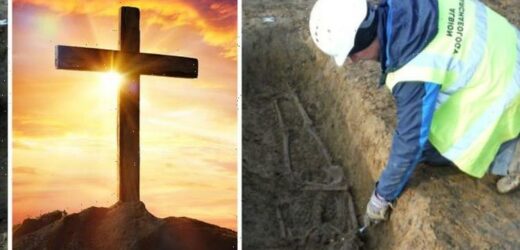Christianity ‘turned to archaeology to promote bible’ says expert
We use your sign-up to provide content in ways you’ve consented to and to improve our understanding of you. This may include adverts from us and 3rd parties based on our understanding. You can unsubscribe at any time. More info
It came after the remains of a man, who had a 5cm iron nail embedded in his right heel, were found in the village of Fenstanton, Cambridgeshire. It was placed alongside a wooden board he is thought to have been pinned to. Experts have dated the man’s age between 25 and 35, and his emaciated skeleton suggests he was most likely a Roman slave.
The discovery was made by a team of researchers who were analysing the site ahead of a housing development being built in 2017.
They have determined that the man died between 130 AD and 337 AD after radiocarbon dating.
It is the first example of a Roman crucifixion in the UK, and one of only a handful of similar cases worldwide.
David Ingham, who led the excavation, told the Telegraph: “It’s the best example of a crucified individual from the Roman world.


“We’d like to stage a reconstruction at some point to see what he looked like.
“We’d use the skull and recreate the whole body.”
It is thought that the man had been badly injured by his master during his lifetime.
The team say he was likely crucified on a roadside half a mile away from the small cemetery in Fenstanton where he was buried.
Crucifixion was the main form of punishment for the Roman Empire.
It was designed to prolong an agonising death and to serve as a warning to others.

It was made popular thanks to the Bible story of how Jesus Christ was crucified.
But despite its link with the Bible, experts believe there was no religious element in this case.
Biblical texts refer to crucifixion taking place with wooden crosses, but using a wooden board instead is thought to be a local variation.
No other nails were found in the man’s body, suggesting that he was tied to the wooden frame with rope and the heel bone nail was to prevent him from moving.
There was a 1cm-deep hole near where the nail was embedded in his heel, suggesting more than one attempt to pin his body to the wood.
DON’T MISS:
Priti Patel extends deadline for asylum applications [REVEAL]
Inmates take swift revenge on tragic Arthur’s ‘evil’ stepmother [INSIGHT]
Covid: Boris can’t impose ANY more lockdowns after party [LIVE]


Archaeologists believe he would have hung for more than a day slowly dying.
It comes after an archaeological discovery challenged the location where Jeuss is said to have performed many miracles.
There are two separate locations as the most likely location of Bethsaida – the archaeological sites of et-Tell and el-Araj.
The two sites, though only 1.2 miles apart, have emerged as the leading candidates for Bethsaida but, according to a report in Live Science, there is absolutely no agreement over which site takes the crown.
One team of researchers from the University of Nebraska Omaha believes et-Tell is the biblical site and has been excavating the ruins of the more than 3,000-year-old settlement since 1987.
But discoveries made at el-Araj have cast a shadow of doubt on this site and according to Jodi Magness, a professor in the Department of Religious Studies at the University of North Carolina Chapel Hill, there is “relatively scant” evidence of a thriving settlement at et-Tell around the time of Jesus’s ministry.
Source: Read Full Article

